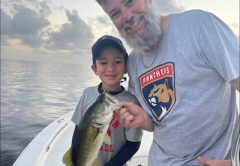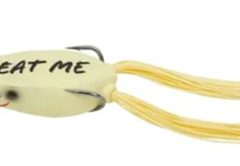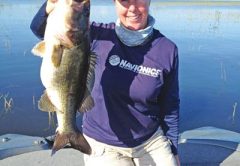
We all have been there, after a hard fought battle with a trophy bass we pluck the fish out of the water, de-hook the fish and then hold it up for the camera to get that memorable picture. Or perhaps the fish goes straight into the livewell for the tournament weigh-ins and photos at the end of the day. From the majority of pictures we see, anglers have yet to embrace the concept of supporting a large fish, especially egg bearing females with two wet hands. To improve the survivability rate of these fish to live and fight another day, we anglers must handle these breeders in the best possible manner. ‘Catch and Release’ does not work if the fish can’t survive after it is released.
The technique that is most commonly used, the grabbing of the bass by its lower jaw and then lifting the full weight of the fish vertically out of the water places an extreme about of pressure on the lower jaw. In many cases this can lead to a broken or dislocated jaw which can have long term consequences on the fish or even be life threatening.
The best technique to hold a trophy fish starts with wetting both your hands so not to destroy the fish’s slim coat. Then using your dominant hand grip the fish with your thumb inside the mouth and your fingers locked on the outside of the mouth. Place your other wet hand just past the anus of the fish to support the weight of the fish. Lift the fish out of the water in a horizontal position using both hands for support. Do not hold the fish by the jaw in a vertical position.
If you plan on taking photos do so in a timely manner, the longer the fish is out of the water the more stress the fish will be under. For the average person, a simple rule to determine how long a fish can be out of water is to hold your breath while you take your pictures. If you need to breathe then put the fish back into the water to allow it to breathe as well. If possible try to keep the fish out of the water no more than 30-seconds.
In addition to the proper holding of a fish there are some things you can do to minimize damage to a fish that could lead to delayed mortality, the death of the fish after it is released. Other than physical tissue damage to a fish from removing a hook deep it the fish’s gut or gills, the number one cause of delayed mortality is fish stress. Sources of stress include heat stress, low oxygen stress, handling stress, and in cases of deep water fish decompression.
When a fish is caught its ‘fight or flight’ mechanism pushes the fish’s metabolic rate into overdrive, the muscles work harder, lactic acid begins to build in its system, and it’s oxygen levels begin to crash. In an attempt to divert energy to key muscles and organs, the fish starts to shift energy way from non-essential functions such as its immune system which then leaves the fish in a weakened state against bacterial, fungal and viral infections. Just as the human skin and mucous membranes are our first line of defense from foreign bodies, the slim coat is the first layer of defense for a fish. When handling a fish, take extra caution to do no harm to the fish’s slim coat. This means if fishing from the shoreline or riverbank don’t drag the fish out of the water over gravel, weeds or grass. If fishing from a boat don’t allow the fish to lay on the hot carpet or boat deck and always pick up the fish using wet hands.
Heat stress especially in south Florida summers can be a silent killer for bass. Placing fishing is a super-heated livewell can kill a fish in minutes. Always check your livewell before you go out and while out on the water. Ensure the aerators and recirculating pumps are working and are not clogged. As the water temperature rises in the tank, cool it off by placing frozen bottles of water in the well. Maintain tank temperature to within 5-degrees of the lake’s temperature. There are plenty of additives being marketed today for reducing the stress on fish in a livewell but nothing beats a livewell with clean, fresh, well oxygenated water maintained at ambient lake temperature.
The last but most important item in improving the survivability of a fish once it is caught is the safe removal of the hook. The mantra should be ‘do no additional harm’ to the fish. If a fish has a hook imbedded deep within its mouth, don’t go digging for it like it’s some lost family heirloom while tearing tissue at the same time. It’s only a hook, they’re cheap and easily replaced, a 10-lb female bass isn’t. Besides having the proper long nose pliers and de-hooking tool, have a stout pair of wire cutters capable of cutting the hook. Most of the time just cutting the shank of the hook will give you the ability to remove the point and barb of the hook. If not then at least the fish has less metal to contend with to survive.
Remember, ‘Catch and Release’ only works if the fish survives to fight another day, anything less is a waste of Mother Nature’s blessings.






